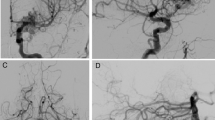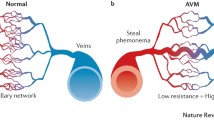Abstract
Cerebral arteriovenous malformations (AVMs) are thought to result from a failure of embryogenesis in the otherwise normal differentiation of primordial vascular channels into mature arteries, capillaries, and veins. Although these are essentially congenital vascular malformations, marked enlargement and/or recurrence of cerebral AVMs has been reported in the recent literature. Using MEDLINE (1966–1998), we searched the recurrence of cerebral AVMs and analyzed all reported recurrent cases after total surgical extirpation and negative postoperative angiogram, and discussed the proposed mechanisms of the recurrence of cerebral AVMs. A thorough literature survey disclosed only 12 documented recurrent cases (9 were documented in English and 3 in Japanese), which shows the rarity of the recurrence of cerebral AVMs, although the actual rate of recurrence is not known because of the lack of routine long-term followup. The location of recurrent cerebral AVMs was the cerebral hemisphere, and initial presentation was hemorrhage in all cases. Recurrence occurred in patients under 20 years of age in 9 of 11 cases, which implies the propensity of recurrence of cerebral AVMs in immature brain vasculature. There are no definite proven mechanisms to explain why congenital anomalies such as cerebral AVMs recur after total extirpation, but recently two plausible mechanisms have been proposed. One is angiogenesis disregulated by vascular endothelial growth factor (VEGF) and the other is a new anatomical entity, ‘hidden compartments’. Although VEGF is one of the main angiogenetic factors and its important role in fetal brain and pathological neovascularization has been reported, the synthesis of VEGF might be insufficient to explain the recurrence of cerebral AVMs because VEGF-positive staining is also found in nonrecurrent patients. Hidden compartments are angiographically unfilled compartments, in spite of an adequate examination, which may be located within, contiguous with, or relatively far from the angiographically demonstrated AVM. Although it might explain unsolved clinical phenomena such as regrowth, recurrence, and per- or postoperative unanticipated bleeding and brain swelling, the existence of hidden compartments should be proved by high-resolution radiological examinations or during operations. The presence of recurrent cerebral AVMs after complete extirpation by modern microsurgical techniques indicates that cerebral angiography in the early postoperative stage, the golden standard to assess the disappearance of cerebral AVMs, is not sufficient to eliminate the risk of hemorrhage, and careful long-term follow-up studies should be planned.
Similar content being viewed by others
Papers reviewed
Fuwa I, Wada H, Matsumoto T (1988) Recurrence of arteriovenous malformation after disappearing on postoperative angiography: report of two cases. No Shinkei Geka 16:887–891
Higuchi M, Bitoh S, Hasegawa H, Obashi J (1991) Marked growth of arteriovenous malformations 19 years after resection: a case report. No Shinkei Geka 19:75–78
Kondziolka D, Humphreys RP, Hoffman HJ, Hendrick EB, Drake JM (1992) Arteriovenous malformations of the brain in children: a forty year experience. Can J Neurol Sci 19:40–45
Gabriel EM, Sampson JH, Wilkins RH (1996) Recurrence of a cerebral arteriovenous malformation after surgical excision. Case report. J Neurosurg 84:879–882
Kader A, Goodrich JT, Sonstein WJ, Stein BM, Carmel PW, Michelsen WJ (1996) Recurrent cerebral arteriovenous malformations after negative postoperative angiograms. J Neurosurg 85:14–18
Sonstein WJ, Kader A, Michelsen WJ, Llena JF, Hirano A, Casper D (1996) Expression of vascular endothelial growth factor in pediatric and adult cerebral arteriovenous malformations: an immunohistochemical study. J Neurosurg 85:838–845
Pellettieri L, Svendsen P, Wikholm G, Carlsson CA (1997) Hidden compartments in AVMs: a new concept. Acta Radiol 38:2–7
Author information
Authors and Affiliations
Corresponding author
Rights and permissions
About this article
Cite this article
Hashimoto, N., Nozaki, K. Do cerebral arteriovenous malformations recur after angiographically confirmed total extirpation?. Crit Rev Neurosurg 9, 141–146 (1999). https://doi.org/10.1007/s003290050123
Published:
Issue Date:
DOI: https://doi.org/10.1007/s003290050123




